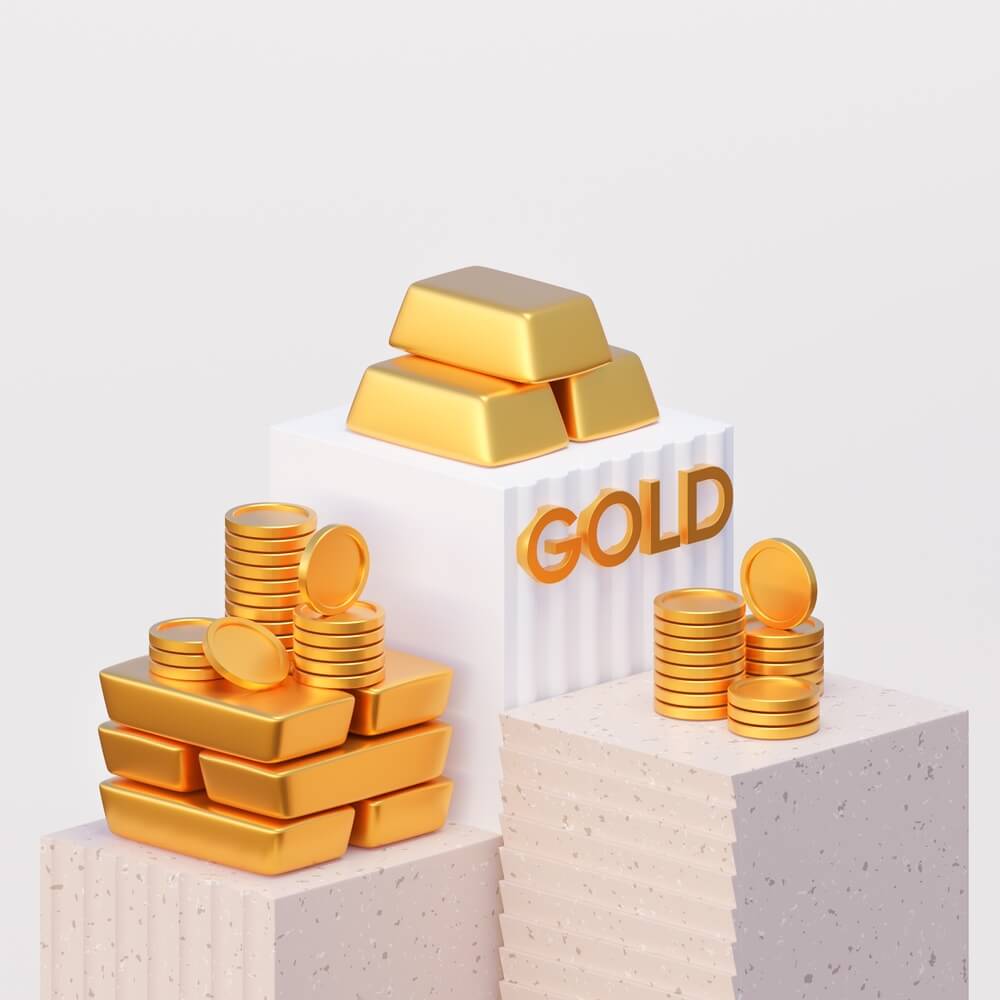
Gold Price: All That You Need to Know
Gold is a stable asset. Unlike paper assets, it’s intrinsically valuable. External events considerably determine gold’s price, but those externalities can never push gold prices to zero. No such historical event has been recorded to date. Since the inception of gold and humankind’s appreciation for it, the precious metal's aggregate value has increased.

Gold is a sought-after asset. Do note that gold doesn’t pay any interest or dividend money except for in the case of digital gold assets. That, however, hasn’t caused a dent in the popularity of physical gold. Gold’s durability, rarity, and beauty have significantly contributed to its mass appeal. But gold is more than just a durable showpiece. It has industrial uses and is considered a valuable asset in the financial market, too.
Table of Contents
Traders and investors closely monitor the price of gold, offering insights into economic and geopolitical scenarios. This article will, therefore, focus on gold prices, what drives them, the significance of gold prices, and more. To offer you a complete understanding about the topic, we’ll focus on the following:
- Why is gold valuable?
- Who ascertains gold prices
- Factors affecting the price of gold
- Gold price over the years
- How recessionary phases affect the price and more
Gold is a broad topic. Upon digging in, you’ll realize each aspect warrants a deep-dive look. Read on to learn everything there is to prices of gold.
Read more: What Affects Gold Prices
Why is Gold Valuable?

Gold is valuable because it’s rare and a sign of wealth. A gold bullion coin cannot be made for every individual on earth due to the finite quantity of gold in the world and the sheer difficulty attached to mining new gold. Moreover, a significant chunk of the gold already discovered is locked in banks and people’s homes, considerably cutting down the circulation of gold in the open market. Although the world’s off the gold standard, several countries continue to hold large gold reserves to be ready for uncertainties.
Also, gold is among the most prized precious metals because it looks and works great. The shiny luster is unique and impossible to replicate. The mysterious allure and natural shine entrap your gaze right off the bat. Unlike several other metals, gold doesn’t deteriorate in quality or corrode, boding well for long-term storage. It continues to maintain its splendid looks irrespective of its environment and circumstances. These are some of the several reasons gold is one among the coveted precious metals.
Who Sets Gold Prices?
Until recently (2015), London Gold Fixing (also called Gold Fix) set gold prices twice every business day. The price was set once at 10:30 in the morning and one more time at 3:00 PM in USD, British pounds, euros, Canadian dollars, and a few other important currencies. On Christmas and New Year’s Eve, the fixing is done only once, in the morning. The price is fixed to settle agreements between London bullion market members. However, the price set is viewed as a benchmark for setting the gold price for most gold products and derivatives across the globe.
The gold fixing was first carried out on September 12, 1919. The gold price per ounce then was set at £4.93. The gold price in New York was $19.39 at that time. Due to the London gold market’s closure, London gold fixing activities were called off between 1939 and 1954. Until 1968, live gold price was fixed just once a day. The second fixing at 3 p.m. was introduced to correspond with the US markets’ opening.
The price setting begins with the price proposed close to the current price or gold spot price. Mock trading is then carried out at that price. All banks participating in the process review their limit orders and ascertain how many can be traded at that price. The banks later assert a single value. After every bank offers its values and the overall net sum is zero, the price fixing is done. If there are flags, the chair will alter the proposed price.
If the quantity of gold a bank proposes to purchase exceeds the proposed sale amount, the chair will increase the price. Conversely, the chair decreases the price if the proposed sale amount is higher. It’s worth noting that the spot gold price was set at $850 in January 1980, and the prices didn’t breach that threshold until January 2008. Do note that the London Gold Fix is no longer operational, replaced by the LBMA (London Bullion Market Association) Gold Price in 2015. Fifteen accredited market players are contributing to LBMA’s gold price.
Factors Driving Gold Prices
Several economic factors determine gold prices. Inflation, supply and demand, market sentiment, etc., are crucial drivers. Let’s discuss them in some detail.
Supply and Demand
Supply and demand are the most significant factors affecting gold prices or the value of any commodity or service. Although gold seems everywhere, it’s a finite source with a limited supply. Any alterations in gold supply significantly impact the precious metal’s prices. Demand also plays a substantial role in ascertaining the gold price. When demand goes up, the price of gold spikes as well.
When gold miners churn out gold in excess relative to demand, the law of economics causes the price to spiral downward. Investment demand is another form of demand driving the price of gold. Gold ETFs (exchange-traded funds) are securities that invest in the metal and issue shares for investors to trade just like stocks.
Inflation
When inflation or the prices of commodities increase, the value of paper currencies diminishes, decreasing paper money’s purchasing power. People flock to gold to safeguard their wealth, increasing the demand and price of gold. However, there are instances when gold has performed poorly during high inflation. But those were also periods when the markets were rallying, thanks to tax cuts and rising interest rates.
As a result, people had more money in their pockets and were willing to invest in stocks. When interest rates go up, the price of gold usually takes a hit, or there’s an inverse relationship between the two. The gold spot price will increase if the financial market fails. But if both the live prices of gold and the share markets rally simultaneously, assessing the whole economic scene before concluding that gold is not a veritable inflation hedge is advised.
Market Activities/Sentiments
Market volatility and uncertainty often drive investors toward gold and silver and other physical precious metals to seek refuge for their wealth. Besides the financial market, the overall market sentiment or the collective behavior of traders and investors toward the gold market can influence the price of gold. Investors speculating what central banks and governments will do and acting accordingly cause gold price changes.
New York, London, and Hong Kong are the world's biggest gold markets. The series of events in those places have a ripple effect on global markets. Certain political factors could also cause prices of gold to go up quickly. For instance, a terror attack or war can cause prices to rise. If people fear an economic downturn, that sentiment could cause prices of gold to go up even if the dollar is strengthening.
Read more: What are Gold Mining Stocks?
Industries Affected by Gold Price Movements
Since gold is aesthetically pleasing, ductile, durable, and corrosion-free, it’s used in many industries. So, fluctuations in the current value of gold will impact them all in some way.
- Coinage: Although most coins are made of stainless steel and metal alloys, a significant chunk is made of the yellow metal. Most coins made for investing or collecting are pure gold, including the American Eagle and Canadian Maple Leaf coins.
- Electronics: Every laptop, smartphone, or other electronic item holds some gold. Although the gold added to modern electronic goods is not as high as before, there continues to be some gold in them. Poor people in underdeveloped parts of the world rummaging through electronic waste to get their hands on some gold is a sign that electronic goods possibly contain gold or other precious metals.
- Medicine: Thanks to its non-reactive nature, gold is used in medical devices and also as treatment. For instance, gold is used as a drug in treating rheumatoid arthritis. Some surgical equipment and tools contain traces of gold. Dentistry uses gold to make fillings, crowns, bridges, and orthodontic appliances.

Historical Gold Prices
Gold hasn’t been deemed precious always. Centuries ago, people had gold and silver coins on them routinely. Things, however, changed after that, especially after it became common knowledge that gold is more than just metal to mint coins. The following ascension in gold value over the decades would give a picture.
| Year | Gold Rate (per ounce) |
| 1950 | $40.25 |
| 1955 | $35.15 |
| 1960 | $36.50 |
| 1965 | $35.50 |
| 1970 | $37.38 |
| 1975 | $140.25 |
| 1980 | $589.50 |
| 1985 | $327.00 |
| 1990 | $391.00 |
| 1995 | $386.70 |
| 2000 | $272.65 |
| 2005 | $513.00 |
| 2010 | $1,410.25 |
| 2015 | 1,060.20 |
| 2020 | 1,895.10 |
Source: Macrotrends
Notes:
- The above prices denote the price at the end of the respective years.
- Gold prices were relatively stable during the early 1900s and before that.
The highest price hit was around $2,075 an ounce of gold in August 2020.
How Did Recent Recessions Affect Gold Price
Conventional wisdom states gold price goes up during a depression, recession, or any other economic slump. So, what happened to gold prices during the latest market calamities?
Gold is a scarce commodity. On the other hand, stocks and shares can be regenerated at will. Gold and the stock market have very little correlation. That means modifications in the price of gold are primarily independent of stock performances. Although the 2007 subprime mortgage crisis is the most publicized stock market crash in recent years, the world has witnessed a dip or recession-like activity thrice after 2000. And on all those three occasions, gold has rallied while the S&P 500 has dipped.
| Year | Recession Duration (in months) | Percent Change in Gold’s Nominal Price | Percent Change in S&P 500 |
| 2001 | 8 | 5.0 | -1.8 |
| 2007 | 18 | 16.3 | -37.4 |
| 2020 | 2 | 5.6 | -1.4 |
Source: Visual Capitalist
Although the rise in gold prices during the last few recessions hasn’t been dramatic, the increases have been positive, cementing gold’s status as a savior against economic turmoil. During these financial crises, particularly the 2007 stock market collapse, gold demand increased as people started to buy gold and safeguard their wealth. From 2007 to 2011, the price of gold doubled. It was $836.50 and $1,574.50 in 2007 and 2011, respectively.
Needless to say, when the market stabilizes and people gain the appetite again to put their money in riskier asset classes, gold prices stagnate or experience reduced growth. But the price of gold rarely reverts to an earlier price point or will almost never drop to prices from the ‘70s and ‘80s. The momentum gained during a financial crisis is more or less sustained because most people who procured gold during the tough times are not putting it out in the open market.
The Current Price of Gold
The current gold price (February 20, 2023) is $1,843.19 an ounce. The gold price per gram is $59.11. The gold price per kilo is $59,111.40. Since the prices change twice a day, the gold price today won’t be the same some other day. Also, gold value is usually measured per ounce and not one troy ounce.
Read more: Top Gold IRA companies in the US
Conclusion
Gold is a store of value with a history to prove that. Therefore, add gold to your investment or retirement portfolio irrespective of what the pundits say. Though not a growth driver per se, gold provides much-required stability to an investment kitty that is otherwise constantly in flux, thanks to stock and bond investments. However, it’s important not to buy more gold than what you can chew or to the extent that completely offsets your portfolio’s balance. Ideally, no more than 5 to 10 percent of your total investments should be gold.
Similarly, buying gold at the right time and the correct price is fundamental. As much as possible, do not buy gold when the market is in turmoil. That’s when people buy gold more than usual, pushing gold spot prices up and making the purchase costlier than it could have been. If you’re not current with the market or cannot predict when it will take a hit, get more familiar with the industry. It’s best not to buy gold when everyone’s doing it. Buy gold when there’s not much of a frenzy or the market is not abuzz with gold news.
To confirm you’re buying gold at a reasonable price, go through historical charts. Gold price charts will provide you with all the information you need about the price of gold over the years and decades. Click on this link for a gold price chart to get you started. Also, refer the live gold price chart displayed on this site.
FAQs
What impacts gold price?
Supply and demand play a significant role in ascertaining the price of gold. Trading trends and how much fresh gold mining companies dig out and make available in the market affect supply. Inflation and market sentiment affect demand. If central banks hold on to their gold reserves and the industry needs more gold, demand will outshine supply, causing the prices to go up. If speculators hoard or let go of the precious metal in the market, the temporary imbalances created will lead to significant price changes.
What are gold’s “bid price” and “ask price”?
Bid and ask prices of gold or any other commodity are price quotations that help determine the best price for the security. The “bid price” denotes the maximum a buyer is okay paying to procure a unit of gold or share of stock. “Ask price” is the least price a seller will be fine selling gold for. The difference between the two prices indicates the asset’s liquidity. The narrower the spread, the greater the liquidity. The bid-ask prices of gold may vary with weight or per ounce/gram.
How to invest in gold?
Although gold’s a physical commodity, you can purchase gold or gain exposure to gold prices through physical and digital gold. If you’d like to invest in physical gold or the allure draws you toward the metal, gold coins and gold bullion bars are solid options. Although gold jewelry is also a physical form of the precious metal, it’s not investment-friendly due to the high margins or the little gold offered for the price.
If you’d like to shun the gold coin and gold bullion bars due to the significant storage and insurance expenses associated with owning the metal physically and go the virtual gold route instead, start investing in shares of gold mining companies, gold mutual funds, ETFs, etc.
Why did gold prices not rally much in 2022?
The 2022 economic climate was relatively gloomy. Gold price, however, didn’t go up significantly during the period due to rising interest rates. That means gold bullion holdings (gold bars and gold coins) are not as profitable as holding money in bonds or saving accounts and earning interest money from them. Since gold offers no returns, the foregone opportunity costs are greater than usual, causing few people to flock toward gold bullion.
This arrangement, however, is temporary, and people who choose to put their money in gold will benefit in the long run due to the eroding buying power of the US dollar. Therefore, have some gold in your portfolio and some silver and platinum to better prepare for the future. And because gold is a slow horse, it will take some time for the precious metal’s prices to increase. Do not expect Bitcoin-like price movements.
What does gold spot price mean?
The spot price of gold is the current gold price or the price at which you can buy gold bullion right now. Gold spot prices differ from gold futures prices as the latter is meant to lock a price in for the future. Gold futures contracts determine the predetermined future date of payment and date of delivery.
Why is there so much variation in the retail price of gold?
Although the LBMA sets prices, buyers may not be able to procure gold at that price in the retail market. Dealer fees and markup, the seller’s interpretation of the market, the type of gold product (bullion gold or jewelry), etc., determine the final price. The dealer markup could vary considerably between stores or dealers and hinge on multiple factors, such as competition, location, and overheads. Some gold dealers take immense pride in their stores’ reputation and customer service and may sell gold at a higher price.
Does gold continue to grow in price?
Although gold is a relatively stable asset than stocks and cryptocurrencies, it’s not always a bull market. Gold definitely has had its share of ups and downs in the past, and that will continue to be the case in the future. If gold had risen in value consistently, it would have now been too expensive for all. That is why allocate no more than 10 percent of your portfolio to gold. Purchase gold only as a defensive measure: a safety net against currency devaluation, inflation, etc.
Does the price of gold impact the economy?
The price of gold is usually a reflection of the state of the economy. In other words, gold price doesn’t rise or dip in a silo. It, therefore, will be correct to say the economy affects the prices of gold and other precious metals and not the other way around.


